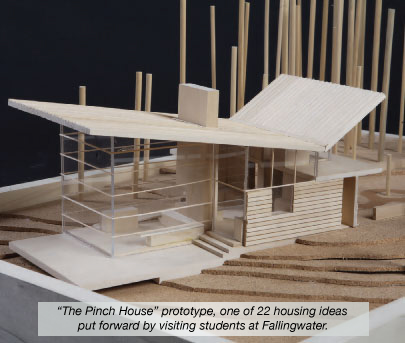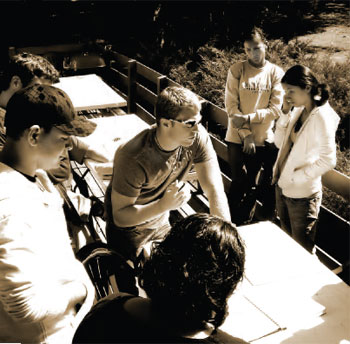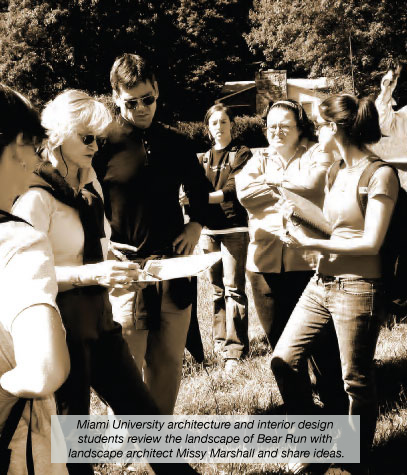New Green Lodging Enhances Educational Opportunities
At once a cultural landmark, a museum and a work of art, Fallingwater serves as a rich resource for students, teachers and people of all ages who are interested in learning about art and architecture. Opportunities to learn on the grounds of Fallingwater abound through volunteer opportunities, outreach programs with local schools, guided tours, programs for adult learners and several residency programs.

Some of these programs, such as residencies, require overnight stays at Bear Run. But living quarters for participants are currently very cramped. “Right now, we’re often putting 16 people in a four-bedroom house,’ said Lynda Waggoner, director of Fallingwater and vice president of WPC. “We want to have enough housing on-site so that we can provide more intensive educational programming.”
For this reason, WPC plans to build six small housing units for educational program participants. Fallingwater will hold an invited design competition for architects, who will be challenged to design structures worthy of sharing grounds with Frank Lloyd Wright’s masterwork. Because Fallingwater is built in the middle of the pristine Bear Run Nature Reserve, the new housing units must be on the leading edge of green design. The budget for this project has been estimated at $1 million, which will include construction and architect fees.
The 600- to 800- square-foot units will not be identical, but each will have full utilities, including recycled water and sewage, a basic kitchen, a fireplace, and shower. They will be designed to be easily maintained during three seasons and just as easily closed over the winter. “Contestants should not only integrate good design and modern technology into their ideas, but also should ask themselves how living in harmony with nature is inseparable with the modern ideals of good design,” said Cara Armstrong, Fallingwater’s curator of education.

This may be Fallingwater’s first design competition, but it certainly isn’t the first time that staff members have asked architects to share their ideas. Students of architecture come from all over the world to study Fallingwater. Some of their studies have resulted in built projects such as new furniture in the servants’ sitting room at Fallingwater.
Students also have helped Fallingwater staff members crystalize their thinking about on-site housing for educational use, by developing and presenting site plans and housing prototyes such as the “Pinch House,” shown on this page. The Pinch House was developed by Kevin Leciejewski and is one of 22 sustainable housing ideas shared by visiting students from The Miami University Department of Architecture and Interior Design.
“Students help us think about what we want. Their work lets us think about the site in different ways and work through ideas visually and three-dimensionally, though models. In addition, their work has helped us share Fallingwater and advance ideas about sustainability internationally, as some of the student work has been published in the Italian magazine And,” said Armstrong.

For the current architects’ competition, the winning design will use energy-efficient and environmentally friendly building materials, but there is more to making a building “green” than how it’s built. The design also should place the building in a position to maximize natural heating and cooling opportunities and minimize environmental impacts. Bushes and shrubbery, placed strategically, will help to block cold winter winds or channel cool summer breezes. Lighting will be low-wattage; water-conserving toilets and showers will be used; and great thought will be put into the placement of electrical wiring and electronic equipment, in order to minimize electromagnetic field exposure.
“It’s a given that the housing will provide program participants with multiple opportunities to recycle, but we’re also stressing that the structures themselves should be built largely of recycled and reused materials,” said Armstrong. “Building materials will need to be durable and should be available locally, to limit the amount of transportation needed to collect materials.”
To stay up-to-date with this project, visit Fallingwater.org.
2009 Members' Day and
Annual Meeting
WPC invites our members to celebrate what we’ve accomplished together. We’d also like to thank you for your loyal membership support.
The Fallingwater Cookbook
The Fallingwater Cookbook takes readers into the kitchen of Fallingwater and the world of the Kaufmanns, who entertained many famous guests at their weekend retreat.
Safeguard Your Future
For 77 years, the Western Pennsylvania Conservancy has protected this region’s land, water and wildlife. We haven’t done it alone – as a loyal member, you have played a vital part.
Become a Member
Our commitment to protect the land, water and life of Western Pennsylvania could not continue without the generous support of members like you.
Volunteer with WPC
Volunteering is an excellent way for WPC members or other concerned citizens to become actively involved. Become a volunteer today!
